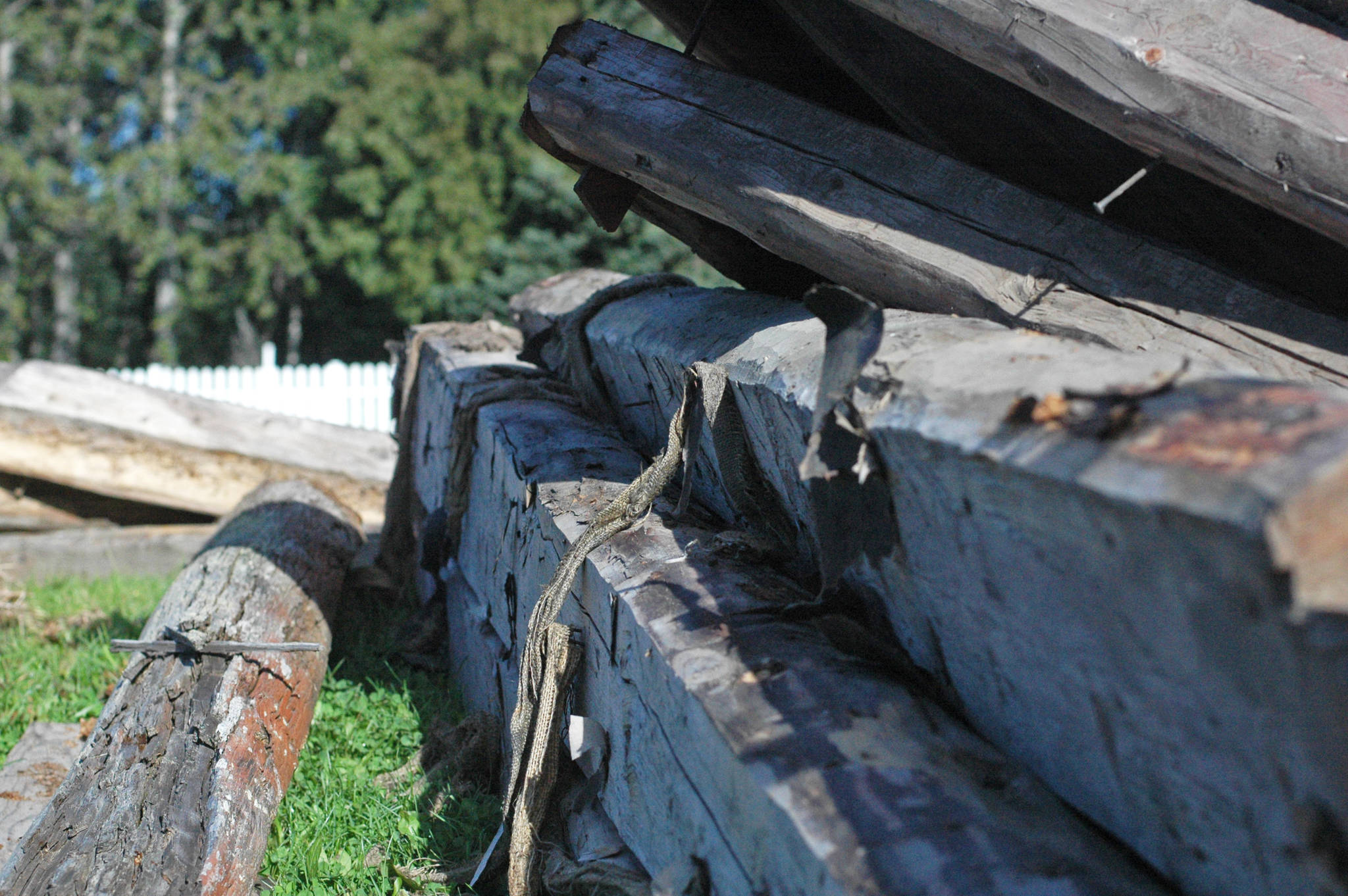A bent, broken old cabin with a long history is getting new life after decades of decay.
A pair of workers have been carefully taking apart and numbering the logs of an old cabin on Petersen Way in Old Town Kenai, right across the street from the landmark Holy Assumption of the Virgin Mary Russian Orthodox Church. Situated between the bluff above the north Kenai beach and the popular Veronica’s Café, many visitors know it as the sunken cabin with a “No Trespassing” sign adjacent to the road.
Plenty of people have been curious about what’s going on. Roy Beaver, one of the workers restoring the cabin, said some people have approached them to ask why they’re taking it apart.
“We’ve said, ‘No, no, no, it’s going back up soon,’” he said. “And they say, ‘Whew, good!’”
Tim Wisniewski, who owns the property where the cabin sits with his wife Terri, said they’re planning to fully restore the cabin. Concerned about the loss of history in the Kenai area, he said they plan to fully restore the place with a foundation and new floorboards, reusing as many of the original logs as possible.
The little place, about 12 feet square, once belonged to Kenai’s jailer, Tommy Foster. Jim Arness, whose grandparents Allen and Jettie Petersen lived in the cabin on the bluff, said he moved to Kenai from the Shumagin Islands when his grandparents did and lived in the cabin next door until he moved later moved onto his own homestead. Arness once owned and ran his accounting practice out of his grandparents’ cabin, which perches on the bluff above the Meeks Trail and the north Kenai beach.
“That’s what we always called it — Tommy’s cabin,” he said.
The place is small, but it has a tin roof atop the logs. Arness said he thought the tin might have come from the wreck of the Corea, a ship that ran aground near Clam Gulch bearing a load of tin. Some of the old houses in Old Town Kenai were build from or have pieces from the tin recovered from that wreck, he said.
Foster wasn’t the one who built the cabin, though — it predates when he moved in, around 1946. Arness said it’s been in disrepair as long as he could remember.
The Kenai Historical Society doesn’t have much information about it either, though they hope to gather more, said Kenai Historical Society President June Carter. Eventually, they may look into putting up a plaque about the cabin when they’ve gathered enough information about it, she said.
There aren’t many buildings left from pre-oil Kenai — many of them are situated along the bluff near the church, and a handful have been relocated into the Kenai Historical Cabins Park on Main Street next to the Kenai Fine Arts Center, which now occupies the original jail building. The Kenai Historical Society gathered the cabins from around Kenai with the help of Peak Oilfield Services, which used a crane and trailer to pick up some cabins and move them to the park to be restored to visitors to see.
Carter said she remembered the fragility of moving the Dolchok-Juliussen cabin from behind the Peninsula Oilers baseball field down to Old Town.
“It was the most difficult because it was still attached to the ground — it had water and electricity,” she said. “I walked beside it, and I heard every creak in it. I swear it was going to fall to toothpicks.”
The park has now been open for eight years, greeting about 900 visitors per summer with a docent guiding tours full of information about Kenai’s homesteaders, from the first general store to the first schoolhouse. Across the street at the Kenai Visitors and Cultural Center, the Kenai Historical Society also maintains two donated historical fishing boats and the original log visitor center, where it keeps its records.
Much of the oldest history of Kenai wasn’t written down or organized in any meaningful way, making it a challenge to categorize, Carter said. The historical society leases a room in the Civic League building from the city that’s full of records that had been “thrown in that room,” she said.
“We moved maybe 60 boxes from that room into the Moosemeat John cabin (the original visitor center),” she said. “We ended up throwing out most of it. People back then took notes onto scrap pieces of paper that had no meaning … you can’t make any sense of it. People would pass away and the family would donate their stuff to the society, and the society did not do anything with them other than just throw them in a box.”
Gradually, they’ve pieced together some of the stories of what Kenai was like in its oldest days, before the oil boom in the 1960s. Much of that has been with the help of homesteaders and their children, oral histories passed down through time. But the physical remnants of old Kenai are patchier.
“We don’t have a lot of old buildings,” Carter said. “They’re going away fast.”
Reach Elizabeth Earl at eearl@peninsulaclarion.com.

